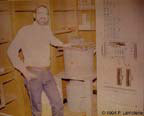|
5. Corroboration of Early Discoveries
of Extraterrestrial Tin Particles in Polar Ice
Tin found in YD boundary samples.
Another very important finding that the YDB group announced at
the 2007 Acapulco AGU meeting is their discovery of large concentrations
of tin at the YD boundary. Darrah, et al. (2007)
conducted SEM analysis of magnetic separates taken from the 12,950
years b2k boundary at several C-14 dated Clovis sites across
the U.S. They found that these separates contained ET markers
such as platinum (Pt) and nickel (Ni), but also certain of these
particles were found to contain ET indicators in association
with volatile metals such as tin (Sn) and copper (Cu). Metal
combinations found included Fe-Ni, Cu-Ni, Fe-Sn-Ni, with particles
in various examples containing 25 - 28% Sn, 12 - 90% Cu, 1 -
11% Ni, and 5 - 98% Pt. The grains were found to be in a metallic
state and relatively unoxidized.
Findings of the 1983 Portland State University study. As mentioned earlier, in the early 80's at Portland
State University I had conducted neutron activation analysis
of polar ice dust as a test of my superwave hypothesis; see figures
5 and 6. As disclosed in my 1983 dissertation and in subsequent
publications, out of the eight Greenland ice samples I tested
that ranged in age from 38.7 to 78.5 kyrs b2k, six contained
high concentrations of ET metallic indicators such as Ir and
Ni, and four also contained high concentrations of volatile metals
such as Sn, Sb, and Ag. In fact one 50,000 year old sample was
found to consist of 60±15% tin (LaViolette,
1983a, 1983c). The tin and iridium abundances found in these
samples are presented in Table I (below). Gold was also found
to be present in the 50 kyrs b2k sample at a concentration of
about 19 parts per million. Correspondingly, gold was found at
2 ppm in clear nonmagnetic particles taken from the Gainey Clovis
site, hence at a level 103
times higher than normal crustal abundance.
Although the Sn, Sb, Au, and Ag in the polar ice samples
were at ratios far higher than are observed in carbonaceous chondrites,
I concluded at the time that they were nonetheless extraterrestrial
and most likely of cometary origin. Whereas carbonaceous chondrite
meteorites lose much of their volatile elements during entry
through the atmosphere due to frictional heating, such would
not have happened to particles dispersed in space as a result
of comets being vaporized by superwave cosmic rays. Micron sized
particles such as these would have been able to enter the Earth's
atmosphere at a relatively low velocity and reach the Earth's
surface unheated in their natural state. Hence they would be
expected to retain their volatile element components. The recent
discovery by Darrah, et al. that certain ferromagnetic particles
present at the YD boundary contain tin along with other ET indicators
should be considered in light of this prior ice core data. For
it is apparent that the tin-bearing dust particles they found
came from the same compositionally anomalous source that produced
the earlier cosmic dust incursions recorded in polar ice.
 (click to enlarge) (click to enlarge)
Figure 5. The author standing next to the
Portland State University gamma ray detector used in his neutron
activation analysis study of ice age polar dust.
|
|
 (click to enlarge) (click to enlarge)
Figure 6. The author processing his irradiated
samples inside a glove bag prior to counting.
|
Table I
Ice Age Cosmic Dust Events
| North
America |
|
|
|
|
|
| |
Age
(kyrs b2k) |
Tin
Concentration |
Iridium
Concen. |
Researcher |
|
| |
12,950 |
25% to 28% |
|
Darrah,
et. al. |
(2007) |
| Greenland |
|
|
|
|
|
Ice
Depth
(meters) |
Age
(kyrs b2k) |
Tin
Concentration |
Iridium
Concen. |
Researcher |
|
| 1166 |
17,000 |
45%
1 of 8 particles |
|
Thompson |
(1976) |
| 1212 |
38,650 |
710 ppm |
16.6 ppb |
LaViolette |
(1983a) |
| 1221 |
45,000 |
|
24 ppb |
LaViolette |
(1983a) |
| 1227.7 |
49,500 |
24 ppm |
6.9 ppb |
LaViolette |
(1983a) |
| 1230.5 |
50,500 |
2-30%
6 of 7 particles |
|
Thompson |
(1976) |
| " |
50,500 |
60 ± 15%* |
56 ppb |
LaViolette |
(1983a) |
| 1241 |
58,700 |
|
96 ppb |
LaViolette |
(1983a) |
| 1275 |
78,500 |
690 ppm |
6.3 ppb |
LaViolette |
(1983a) |
| 1342 |
125,000 |
3 of 5 particles |
|
Thompson |
(1976) |
Antarctica |
|
|
|
|
|
| 1585 |
31,500 |
< 58 ppm |
156 ppb |
LaViolette |
(1983a) |
|
Note:
Ice core depths and ages listed above are updated from values
given in the 1983 and 1985 publications. Core depths given here
record real depth rather than log book depth and ages are older
than previously published ages due to improvements in ice core
chronology.
|